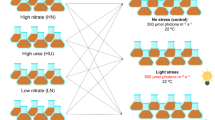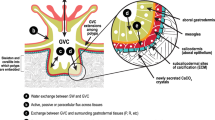Abstract
Dinoflagellates which live in intracellular symbiosis with corals (zooxanthellae), probably share the ionic conditions of their host cells, i.e. are subjected to lower sodium and calcium concentrations than ambient seawater. Although free-living zooxanthellae are not generally found in waters of reef ecosystems, they can be released in either a controlled diurnal regulation or an uncontrolled (coral bleaching) reaction by their animal hosts. Upon release, zooxanthellae experience new external ionic conditions. The aims of this study were to (1) examine the ionic conditions experienced by zooxanthellae in hospite, (2) determine changes in the intracellular Na+ concentration of dinoflagellates (Symbiodinium sp.) following isolation from the scleractinian coral Galaxea fascicularis (Linnaeus, 1767), and (3) characterize the mechanism of Na+ regulation and control. On the basis of equilibrium studies, it has been suggested that zooxanthellae in coral-host cells experience a Na+ concentration of ≃60 mM. The intracellular concentration of Na+ in zooxanthellae, as determined by flame photometry, was found to be ≃0.300 μequiv mg−1 protein, or 30 to 35 mM when the water content of cells was taken into account. Half the cell Na+ seems to be compartmentalized (i.e. non-exchangeable) in freshly isolated zooxanthellae (FIZ), while in cultured zooxanthellae (CZ) all the Na+ was exchangeable. Isolation of zooxanthellae into seawater from their intracellular environment caused a transient two-fold increase in Na+ concentration within the first 30 min. This increase was directly proportional to extracellular Na+ concentration, suggesting passive influx. After 30 min the Na+ concentration decreased, reaching its initial level within 1 to 3 h. Following isolation for up to 3 h, the Na+ influx rate measured during short incubations (5 min) was constant, suggesting that some Na+-regulation mechanism, probably a Na+ efflux system, was created or stimulated within the first 30 min. Since this mechanism is independent of DNA transcription (as proved by its insensitivity to 100 μM actinomycin D) and protein synthesis (insensitivity to 100 μM cycloheximide or emetin), we conclude that activation of an efflux system already present in the zooxanthella membrane occurred during the first 30 min after isolation in seawater. This mechanism was cyanide (CN)- and 3-(3,4-dichlorophenyl)-1, 1-dimethylurea (DCMU)-sensitive and dependent on extracellular K+. However, while we found an ouabain-sensitive ATPase activity in zooxanthella homogenates, suggesting the involvement of a Na+/K+ ATPase, no correlation was found between Na+ efflux and K+ influx [measured using 86Rb (rubidium chloride) as a tracer]. The results presented show that isolation of symbiotic dinoflagellates into seawater causes major ionic stress, resulting in a two-fold increase in intracellular Na+ concentration. Within 30 min, a Na+-efflux mechanism (putatively involving Na+-ATPase), in the membrane of zooxanthellae in hospite is stimulated. The Na+ concentration of the cell consequently returns to its initial level 3 h after isolation.
Similar content being viewed by others
Author information
Authors and Affiliations
Additional information
Received: 4 June 1997 / Accepted: 25 June 1997
Rights and permissions
About this article
Cite this article
Goiran, C., Allemand, D. & Galgani, I. Transient Na+ stress in symbiotic dinoflagellates after isolation from coral-host cells and subsequent immersion in seawater. Marine Biology 129, 581–589 (1997). https://doi.org/10.1007/s002270050199
Issue Date:
DOI: https://doi.org/10.1007/s002270050199




